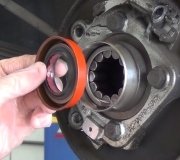Before you take anything apart with the wheel cylinder, try pushing on the shoes or wheel cylinder's pistons to see if they are indeed stuck. You should have to press pretty hard, but you can move the pistons with hard thumb pressure.
In the '80s we always rebuilt them with every brake job. But today new ones are very inexpensive so we just replace them. The ones that get stuck are generally the real small diameter ones that cylinder hones are too big for.
You also have to look at the steel line to see if that soft metal nut is going to come loose. Watch that it doesn't stick to the line and twist it off. Use a flare nut wrench, also called a line wrench. Those grip the nut on four sides instead of two. If the line won't come loose without breaking, you may have to resort to rebuilding the wheel cylinder. Once you have it apart, wash it out, then look inside to see if there are pits or rust spots near the middle. Those will be on the bottom where water settles. If there are pits in it, you have no choice but to replace it. If you don't have a small cylinder hone, or the wheel cylinder is real small, you can put a piece of fine sandpaper through a cotter pin, then stick that in a drill to spin it. Use that to shine up the inside of the cylinder and to clean out any impacted dirt and rust.
If the nut won't spin on the steel line, you can often loosen it a little, then unbolt the wheel cylinder and spin it off that way. You won't have room to do that on some car models.
Don't use penetrating oil on the nut and be extremely careful to not get any petroleum-based contaminants on anything that brake fluid contacts. Engine oil, transmission fluid, power steering fluid, and axle grease will contaminate the brake fluid and make rubber parts swell. The fix for that is REAL expensive. Professionals even wash their hands with soap and water to avoid getting fingerprint grease in there. If you buy a rebuilding kit for the wheel cylinder, when you pop the new lips seals in, lubricate them only with fresh clean brake fluid, nothing else. You can use Brake Assembly Lube, which is just thick brake fluid, but I haven't seen that around for a real long time.
Saturday, November 14th, 2015 AT 1:19 AM


